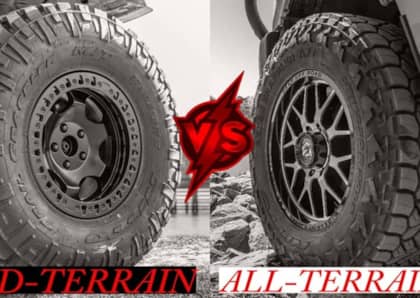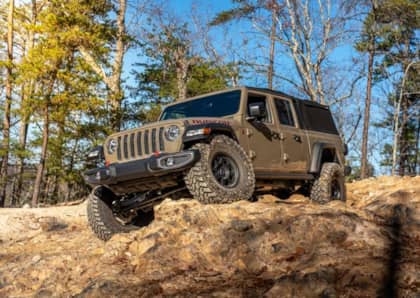Jeep Grand Wagoneer Concept Leans On Luxury SUV Heritage To Take Down Cadillac Escalade and Lincoln Navigator
Jeep's revival of the Wagoneer brand name for a new full-size SUV puts it in a unique position in the world of premium SUVs. Unlike any other American brand operating in the luxury segment, Jeep is the only one able to claim an actual link to high end heritage, with the Wagoneer (and later the Grand Wagoneer) having invented the idea of a plush 4x4 people mover as far back as the early 1960s.

The new Jeep Grand Wagoneer concept therefore provides the automaker with an opportunity not available to relative newcomers like the Cadillac Escalade and the Lincoln Navigator: the chance to leverage classic design cues and tap into nostalgia as it launches its first three-row sport-utility vehicle since the failed Commander from the previous decade. The SUV builder is planning a 'portfolio' of vehicles under the Wagoneer banner, with the Grand Wagoneer sitting at the top in terms of performance and prestige.
Jeep is going to need every ounce of built-in goodwill it can get, too. Although pricing details have yet to be announced, it's safe to assume that a production version of the Grand Wagoneer concept will push well past the $70,000 point as its starting price due to the need to clear the existing upscale editions of the smaller Grand Cherokee. Given the upward trajectory of luxury trucks, it's also a fair assumption that the best-equipped version of the Wagoneer could brush up against the $100k mark.

Does the Jeep Grand Wagoneer concept have what it takes to clash with the Navigator and the Escalade? And just how hard did its designers lean on the work done by the legendary Brooks Stevens, who penned the original Wagoneer more than 50 years ago?
Spiritual Ancestor, Not Spitting Image
The comparisons between the looks of the all-new Grand Wagoneer concept and the original Jeep Grand Wagoneer are unavoidable. Recent years have boosted the profile of Jeep's classic wood-paneled SUV on auction sites and in pop culture, with prices for restored and survivors examples of the regal truck rising at a surprisingly high rate. In many ways the Wagoneer has become the defining image of what an old-school SUV should look like, and it's certainly an icon of its era.

It was clear right from the start that faux-wood grain was a non-starter for any re-imagined Wagoneer, and the concept presented by Jeep relies on more subtle call-backs to evoke the personality of its predecessor. The SUV's large greenhouse, with three wide windows along each side and an equally large hatch, support a tall and upright roofline which is replete with the right angles that defined Stevens' long-standing SUV design. Inside, a two-spoke steering wheel is intended to call to mind the V-shaped spinner on the 80s-era Grand Wagoneer, and numerous teak wood highlights have moved from the exterior to the interior of the Jeep's cabin.

The Grand Wagoneer concept's first impression is both broad and substantial, but it's also thoroughly modern. There are no retro lines to be found in its sheet metal and from certain angles, particularly the rear, the Jeep more strongly resembles one of its primary rivals, Lincoln's massive Navigator. It's also worth pointing out that the classic Wagoneer was a five-passenger truck, which means that the new models proportions have had to push past those of its progenitor from a sheer practicality standpoint in order to fit the desired third row of seating.

Other indications that this is a vehicle intended for a 21st century market include a level of ornamentation and detail in the outside lighting that would have been unthinkably complex for AMC-controlled Jeep in the Grand Wagoneer's '80s heyday, as well as an interior replete with display screens almost everywhere you look.

Helping set Jeep apart from other, equally massive luxury SUVs currently available is the decision to avoid sculpting a massive, gaping maw onto the new Grand Wagoneer concept's front end. With modern designers seemingly in love with the widest and tallest of grilles (all the better for cooling high-strung, turbocharged drivetrains), Jeep has instead stuck with a slim interpretation of its seven-slot grille strung from one headlight to the other and integrated by way of a glowing LED bar just underneath an (also illuminated) W A G O N E E R call-out.
The Battle Of The Interior
With styling that's resolutely Jeep while still speaking to a luxury customer, where the production Grand Wagoneer will have to step up and delivery to be taken seriously at its projected price point is in the features and comforts offered by its cabin, as well as its overall driving experience.

From the images provided by Jeep, it's clear that the Grand Wagoneer concept has taken a step beyond the current Grand Cherokee in terms of interior fit and finish. Not only do the materials used throughout the passenger compartment look a cut above what Jeep customers are used to, but the design of the cabin itself—especially the flowing dashboard—manages to avoid a parts bin appearance. The center console's dual-screen layout and unique rotary shift knob placement (alongside controls for the vehicle's drive modes and adjustable air suspension ride height) is also a breath of fresh air for Jeep, as is the binnacled engine start button.

Is it on par with the sumptuous trappings provided by the Lincoln Navigator and, to a somewhat lesser extent, the Cadillac Escalade? It's difficult to tell without spending time with the truck in person, and the Navigator in particular has set a high bar among domestic luxury SUVs. A major point in the Wagoneer's favor, however, depending on how you feel about the current slate of always-connected automotive technologies, is that Jeep's parent company, FCA, does infotainment better than nearly anyone else in the business. With this many screens on-board, and the introduction of a new Uconnect 5 system, the Wagoneer could be an opportunity for Jeep to digitally transcend the competition.
Off-Road Heritage, On-Pavement Reality
It's a lot more difficult to tell if the Grand Wagoneer concept will be able to beat the best from Cadillac and Lincoln from behind the wheel. Although it's reasonable to expect the Wagoneer to provide a competent experience off-road, no one at Jeep has yet to use the phrase 'trail-rated' to describe its capabilities when the pavement disappears.

While a rugged character was a big part of the original Grand Wagoneer's image, as well as the single most defining characteristic of the Jeep brand today, it's quite low on the list of needs when one is spending nearly six-figure sums on an SUV. Jeep is content to use the word 'leading' to describe the Grand Wagoneer's off-road chops, which is most likely in reference to other Detroit-based SUVs rather than options like the Land Rover Range Rover Sport. That being said, three separate four-wheel drive systems are on offer with the vehicle, similar to how the Grand Cherokee can be spec'd. Suspension will be fully independent front and rear to ensure a smooth daily drive.

Under the hood, and beneath the floorboards, the Grand Wagoneer concept boasts a hybrid electric setup that provides the choice between standard and EV-only operation. Yes, this electrified drivetrain will make it to showrooms, but expect it to be available alongside the ubiquitous 5.7-liter Hemi V8 pushing out close to 400 horsepower. A new inline six cylinder engine is also possible with the vehicle, and if Jeep wants to go up against the 500 lb-ft of torque provided by the scary-quick EcoBoost mill found in the Lincoln Navigator, it has the tools to do so from its deep bench of eight-cylinder options, too.
Forging A New Future For Jeep
The Jeep Grand Wagoneer concept isn't a throwback to days of SUVs past, nor is it a dedicated rock-crawler intended to replace the Wrangler in the hearts of minds of the off-road faithful. To have pursued either of these paths would have been a mistake, as Jeep is better off looking towards its future instead of revisiting the past with anything more than a respectful name-check.

It's also far more profitable to put a Grand Wagoneer in a customer's driveway beside the Wrangler that they already own than to try to build a compromised crawler that attempts to do daily luxury and muddy weekend fun in the same plus-sized, high-priced package.

Jeep's strategy is simple enough to understand: the Wagoneer is here to stop Grand Cherokee and Wrangler customers from heading across town to Cadillac or Lincoln when their families or gross incomes have outgrown what the brand has to offer them. Those buyers will be the core of the Grand Wagoneer's demographic before it starts in on peeling away the faithful from what have been, until now, the only other American-built big-boned luxury SUVs in the game.
More From Driving Line
- Want to learn more about the history of the original Jeep Grand Wagoneer? We've got you covered with this in-depth feature on the world's first luxury SUV.











